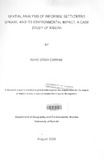| dc.contributor.author | Ojwang', Isaac O | |
| dc.date.accessioned | 2013-05-09T09:38:53Z | |
| dc.date.available | 2013-05-09T09:38:53Z | |
| dc.date.issued | 2009-08 | |
| dc.identifier.citation | Degree of Master of Arts in Environmental Planning and Management | en |
| dc.identifier.uri | http://erepository.uonbi.ac.ke:8080/xmlui/handle/123456789/20710 | |
| dc.description | A Research project submitted in partial fulfillment for the requirement for the degree
of Master of Arts in Environmental Planning and Management | en |
| dc.description.abstract | One of the United Nations Millennium Development Goals is to achieve
significant improvement in lives of at least 100 million slum dwellers by the year
2020 (UN Habitat, 1990). This requires identification of slum settlements and
study of their spatial expansion. Kibera the biggest slum in Nairobi has continued
to expand spatially causing conflicts in land use and a host of environmental
problems. This study was carried out to analyze the spatial sprawl of Kibera over
time and space through the use of satellite imageries. Main research objective
was to establish the pattern of spatial expansion of Kibera through the use of
remotely sensed satellite imageries. Geographic Information System (GIS) was
applied in manipulation of data and various analyses on the imageries. Factors
which have influenced spatial expansion of Kibera were evaluated through
interview data collected from selected respondents in Gatwekera village of
Kibera. GIS and Remote Sensing techniques were used to study the spatial
sprawl of Kibera and to identify the land use and land cover changes that had
occurred, in addition to determining environmental impact of the slum growth.
The study established that Kibera has been expanding over time due to high
immigration rate and this spatial expansion has been accompanied by changes
in land cover and land use. The spgtial sprawl has seemed to be of a definite
pattern; majorly along the railway line and Muitini River and its tributaries
traversing the settlement. In 1976 more than- half of Kibera was under forest
cover, continued sprawl has slowly led to destruction of forest cover to create
room for building houses which .now occupy over 90% of Kibera land area. Other
impacts include: overcrowding, lack of clean water, toilet facilities and poor
sanitation. This study therefore recommended that adequate legislative
measures be put in place to contain further spatial sprawl of Kibera into the forest
reserve and neighbouring areas. High resolution QuickBird satellite imageries
t should also be used to constantly monitor the state of Kibera and the
environmental hotspots for chanqe, Low-cost high-rise buildings to be put up and
essential services: water, sanitation, toilet facilities be provided. | en |
| dc.language.iso | en | en |
| dc.publisher | University of Nairobi | en |
| dc.title | Spatial Analysis of Informal Settlement Sprawl and Its Environmental Impact: a Case Study of Kibera | en |
| dc.type | Thesis | en |
| local.publisher | Department of Geography and Environmental Studies | en |

